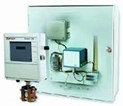Remote Well Site Monitoring

In partnership with Controlsat N/ASolutions, a specialized service provider of LEO-enabled production automation technology, the scanners are now available with the option of reliable, near real-time communications to wellsites around the globe. While the scanners provide computationally superior measurement and control functions, LEO satellite technology operates much the same way as a traditional radio repeater system with one exception, the repeaters are satellites. Scanner data is transmitted via a network of 36 satellites in orbit only 750 km from the earth's surface. These satellites allow producers to replace a large, expensive repeater tower with a relatively low powered transceiver and a simple whip antenna.
Like many other oil and gas producers in the Canadian north, one of the company's customers is challenged with producing natural gas from extremely remote areas and transporting it to market for the lowest possible cost while adhering to stringent environmental and safety standards. Although this particular customer is in the process of replacing its circular chart recorders with Scanner Electronic Flow Measurement (EFM) devices, it is doubtful that with the prohibitive cost of implementing conventional communications to each site the full benefit of automation can be realized.
The elimination of paper charts will provide a significant reduction in operating costs, but the real benefit of gas field automation comes with the elimination of unnecessary wellsite visits. If production data can flow through a communications network to the field office and up through the corporate network to operations, engineering and accounting, with minimal human intervention, then all of the personnel resources previously consumed with gathering data from these sites can be assigned to tasks which will add greater value to the overall business.
For example, an operator tasked with collecting data from traditional chart recorders could conceivably drive to 30 remote wells at least once a week. Using a system of EFM devices linked by an appropriate communications network, the same operator can collect individual wellsite data without leaving the field office and focus instead on increasing the productivity of the field by restricting his visits to wells that require maintenance or improvement. While this task remains reactive, any downtime is reduced to hours as opposed to days. Further, if the data that flows through the corporate network is detailed enough, reservoir engineering can better determine when workovers need to occur, and then the task becomes proactive. Gradually a company realizes even further reductions in reactive activities, optimization of resources, and an overall reduction of operating costs. Savings can be amplified for fields in remote and hostile locations where the only practical method of physically visiting a site is by helicopter.
Traditionally, communications options for data gathering networks have included radio, dial-up modem, cellular, and CDPD systems. Until now, remote field in rugged terrain were economically restricted to radio systems, which still proved to be an expensive option when considering the additional cost of constructing the repeater towers necessary to transmit the data out of the rough area.
For the company's customer, the solution for these remote wellsites was LEO satellite communications. A data concentrator device is located in the field in close proximity to the EFM device but outside of the hazardous area. It polls the EFM for process data and alarm information on an hourly basis and then packages it for transport through the satellite network. This packet is forwarded to a subscriber communicator which is essentially a VHF radio with the smarts to track the constellation of 36 small satellites, each in its own low earth orbit, to provide coverage in excess of 90% of the day. Then, each hour the data is transmitted through the particular satellite that is overhead at that time, and back to a satellite earth station in Virginia. From here, the data is forwarded to the user via a custom format developed specifically so that it could be seamlessly imported by an existing routine into their production accounting system. Data is being formatted into a comma-separated ASCII text file that is sent as an attachment to an email message.
Within a few months, this data will also be provided directly to their SCADA system, giving access tot he data from anywhere on their corporate WAN, in a form that is indistinguishable from any of the other data being collected by conventional land-based communications systems. At present the data can also be posted on a secured Internet site for viewing via a web-browser produced by the satellite provider, in this case Controlsat N/ASolutions.
A solid communications background is key to the development of any effective plan to automate remote wellsites. LEO satellite technology is proven, reliable, accurate and global.
<%=company%>, 900 S. Turnbull Canyon Rd., City Of Industry, CA 91745. Tel: 626-961-2547 (Ext. 532). Fax: 626-961-4452.
